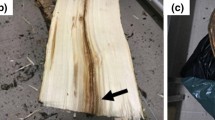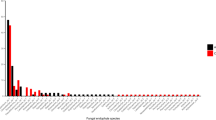Abstract
Isolations from diseased plants and controlled inoculations indicate that the host range of the canker pathogen Luteocirrhus shearii is mainly limited to Banksia. Branches exhibiting canker symptoms were sampled from the Geraldton Sandplains, Swan Coastal Plain, Jarrah Forest, Warren and Esperance Sandplains bioregions of the South-West Botanical Province of Western Australia (n = 1,351). Luteocirrhus shearii was isolated from only Proteaceae and did not infect wound inoculated Myrtaceae. The pathogen was isolated from or formed extensive lesions in 15 Banksia species. Differences in isolation frequency and rates of lesion extension of L. shearii between Banksia spp. may indicate different modes of infection by the canker pathogen. By exerting top-down control of population dynamics of Banksia communities from lower trophic levels, L. shearii would substantially alter host species diversity and in turn ecosystem processes. Predicted climate change could influence future biotic reorganisations following L. shearii invasion. What determines the limited host range of L. shearii compared to the community of organisms on Banksia needs to be determined.









Similar content being viewed by others
References
Australian Government (2013) Australia’s bioregions (IBRA). (http://www.environment.gov.au/parks/nrs/science/bioregion-framework/ibra/index.html#ibrabioregions)
Ayer WA, Khan AQ (1996) Zythiostromic acids, diterpenoids from an antifungal Zythiostroma species associated with aspen. Phytochem 42:1647–1652
Bartyńska M, Mirski W (2005) Fungi occurring on Colorado blue spruce (Picea pungens Engelm.) in the Cracow Botanic Garden. Acta Sci Pol Hortorum Cultus 4:27–37
Bathgate JA, Barr ME, Shearer BL (1996) Cryptodiaporthe melanocraspeda sp. nov. the cause of Banksia coccinea canker in south-western Australia. Mycol Res 100:159–164
Boesewinkel HJ (1976) Storage of fungal cultures in water. Trans Brit Mycol Soc 66:183–185
Burgess T, Wingfield MJ (2002) Impact of fungal pathogens in natural forest ecosystems: a focus on Eucalyptus. In: Sivasithamparam K, Dixon KW, Barrett RL (eds) Microorganisms in plant conservation & biodiversity. Kluwer Academic, Dordrecht, pp 285–306
Burgess TI, Barber PA, Hardy GESJ (2005) Botryosphaeria spp. associated with eucalypts in Western Australia, including the description of Fusicoccum macroclavatum sp. nov. Australas Plant Pathol 34:557–567
Chapin FS, Autumn K, Pugnaire F (1993) Evolution of suites of traits in response to environmental stress. Am Nat 142:S78–S92
Chapman A (2011) Conservation codes for Western Australian flora. In: Flora Base—The Western Australia Flora. (Department of Environment and Conservation: http://florabase.dec.wa.gov.au/conservationtaxa)
Cheewangkoon R, Groenewald JZ, Summerell BA, Hyde KD, To-anun C, Crous PW (2009) Myrtaceae, a cache of fungal biodiversity. Persoonia 23:55–85
Collins K, Collins K, George A (2008) Banksias. Bloomings Books, Melbourne
Crane C, Burgess TI (2013) Luteocirrhus shearii gen. sp. nov. (Diaporthales, Cryphonectriaceae) pathogenic to Proteaceae in the South Western Australian Floristic Region. IMA Fungus 4:111–122
Crane CE, Shearer BL, Barrett S, Dunne CP (2012) Influence of climate on canker disease in the Proteaceae of the Southwest Australian Floristic Region. Proc Australas Syst Botany Soc Conf 2012:26
Crous PW, Summerell BA, Swart L, Denman S, Taylor JE, Bezuidenhout CM, Palm ME, Marincowitz S, Groenewald JZ (2011) Fungal pathogens of Proteaceae. Persoonia 27:20–45
Dakin N, White D, Hardy GESJ, Burgess TI (2010) The opportunistic pathogen, Neofusicoccum australe, is responsible for crown dieback of peppermint (Agonis flexuosa) in Western Australia. Australas Plant Pathol 39:202–206
Davison EM, Tay FCS (1983) Twig, branch, and upper trunk cankers of Eucalyptus marginata. Plant Dis 67:1285–1287
Davison EM, Tay FCS (1995) Damage to surface roots of Eucalyptus marginata trees at sites infested with Phytophthora cinnamomi. Aust J Bot 43:527–536
Desprez-Loustau ML, Marcais B, Nageleisen LM, Piou D, Vannini A (2006) Interactive effects of drought and pathogens in forest trees. Ann For Sci 63:597–612
Díaz S, Lavorel S, de Bello F, Quétier F, Grigulis K, Robson TM (2007) Incorporating plant functional effects in ecosystem service assessments. Proc Natl Acad Sci U S A 104:20684–20689
Feige GB, Ale-Agha N, Nagel B (2001) Microfungi on Rosaceae in eastern Westphalia (Sauerland, North Rhine-Westphalia, Germany). Meded Rijksuniv Gent Fak Landbouwkd Toegep Biol Wet 66:117–132
Fitzpatrick MC, Gove AD, Sanders NJ, Dunn RR (2008) Climate change, plant migration, and range collapse in a global biodiversity hotspot: the Banksia (Proteaceae) of Western Australia. Glob Change Biol 14:1337–1352
Fraser D, Davison EM (1985) Stem Cankers of Eucalyptus saligna in Western Australia. Aust For 48:220–226
Gilbert GS, Magarey R, Suiter K, Webb CO (2012) Evolutionary tools for phytosanitary risk analysis: phylogenetic signal as a predictor of host range of plant pests and pathogens. Evol Appl 5:869–878
Grigg AM, Pate JS, Unkovich MJ (2000) Responses of native woody taxa in Banksia woodland to incursion of groundwater and nutrients from bordering agricultural land. Aust J Bot 48:777–792
Grime JP (1998) Benefits of plant diversity to ecosystems: immediate, filter and founder effects. J Ecol 86:902–910
Groom PK, Froend RH, Mattiske EM, Gurner RP (2001) Long-term changes in vigour and distribution of Banksia and Melaleuca overstorey species on the Swan Coastal Plain. J R Soc WA 84:63–69
Gryzenhout M, Wingfield BD, Wingfield MJ (2009) Taxonomy, phylogeny, and ecology of bark-inhabiting and tree-pathogenic fungi in the Cryphonectriaceae. APS press, St Paul
Gryzenhout M, Myburg H, van der Merwe NA, Wingfield BD, Wingfield MJ (2004) Crysoporthe, a new genus to accomodate Cryphonectria cubensis. Stud Mycol 50:119–142
Gryzenhout M, Myburg H, Hodges CS, Wingfield BD, Wingfield MJ (2006) Microthia, Holocryphia and Ursicollum, three new genera on Eucalyptus and Coccoloba for fungi previously known as Cryphonectria. Stud Mycol 55:35–52
Hopper SD (1980) Bird and mammal pollen vectors in Banksia communities at Cheyne Beach, Western Australia. Aust J Bot 28:61–75
IOCI (2002) Climate variability and change in the south-west Western Australia. Indian Ocean climate initiative. Department Environment Water & Catchment Protection, East Perth
Jackson T (2003) Occurrence and variation of Endothiella eucalypti in Eucalyptus globulus plantations of south-western Australia and the influence of some biotic and abiotic factors on the response of the host to the pathogen. PhD Thesis, Murdoch University
Kirby KN (1993) Advanced data analysis with SYSTAT. Van Nostrad Reinhold, New York
Ladd PG, Alkema AJ, Thomson GJ (1996) Pollen presenter morphology and anatomy in Banksia and Dryandra. Aust J Bot 44:447–471
Lewis KJ, Lindgren BS (2000) A conceptual model of biotic disturbance ecology in the central interior of B.C.: how forest management can turn Dr, Jekyll into Mr. Hyde. Forest Chron 76:433–443
Low AB, Lamont BB (1990) Aerial and below-ground phytomass of Banksia scrub-heath at Eneabba, south-western Australia. Aust J Bot 38:351–359
Mirski W (2008) Fungi colonizing shoots of common yew (Taxus baccata L.) in the Jangiellonian University Botanic Garden in Cracow. Acta Agrobotanica 61:191–197
Moran MD (2003) Arguments for rejecting the sequential Bonferroni in ecological studies. Oikos 100:403–405
Nakabonge G, Burgess T, Gryzenhout M, Wingfield B, Wingfield MJ, Roux J (2008) Population structure of the fungal pathogen Holocryphia eucalypti in Australia and South Africa. Australas Plant Pathol 37:154–161
Oliver RP, Ipcho SVS (2004) Arabidopsis pathology breathes new life into the necrotrophs-vs.-biotrophs classification of fungal pathogens. Mol Plant Pathol 5:347–352
Paap T (2001) The incidence, severity and possible causes of canker disease in Corymbia calophylla (marri) trees in the south west of Western Australia. Murdoch University, Hons Thesis
Paap T, Burgess TI, McComb JA, Shearer BL, Hardy GESJ (2008) Quambalaria species, including Q. coyrecup sp. nov., implicated in canker and shoot blight diseases causing decline of Corymbia species in the southwest of Western Australia. Mycol Res 112:57–69
Sakalidis ML, Hardy GESJ, Burgess TI (2011) Class III endophytes, clandestine movement amongst hosts and habitats and their potential for disease; a focus on Neofusicoccum australe. Australas Plant Pathol 40:510–521
Schnell GR (1987) Investigations of plant diseases in reforestations of the subalpine region in the central Swiss alps. Eur J For Path 17:19–33
Schoeneweiss DF (1975) Predisposition, stress, and plant disease. Ann Rev Phytopathol 13:193–211
Shearer BL (1994) The major plant pathogens occurring in native ecosystems of south-western Australia. J R Soc W Aust 77:113–122
Shearer BL, Tippett JT (1988) Distribution and impact of Armillaria luteobubalina in the Eucalyptus marginata forest of south-western Australia. Aust J Bot 36:433–445
Shearer BL, Crane CE, Cochrane A (2004) Quantification of the susceptibility of the native flora of the South-West Botanical Province, Western Australia, to Phytophthora cinnamomi. Aust J Bot 52:435–443
Shearer BL, Crane CE, Dunne CP (2012) Variation in vegetation cover between shrubland, woodland and forest biomes invaded by Phytophthora cinnamomi. Australas Plant Pathol 41:413–424
Shearer BL, Fairman RG, Bathgate JA (1995) Cryptodiaporthe melanocraspeda canker as a threat to Banksia coccinea on the south coast of Western Australia. Plant Dis 79:637–641
Shearer BL, Tippett JT, Bartle JR (1987) Botryosphaeria ribis infection associated with death of Eucalyptus radiata in species selection trials. Plant Dis 71:140–145
Shearer BL, Byrne A, Dillon M, Buerhig R (1997) Distribution of Armillaria luteobubalina and its impact on community diversity and structure in Eucalyptus wandoo woodland of southern Western Australia. Aust J Bot 45:151–165
Shearer BL, Crane CE, Barrett S, Cochrane A (2007) Assessment of threatened flora susceptibility to Phytophthora cinnamomi by analysis of disease progress curves in shadehouse and natural environments. Australas Plant Pathol 36:609–620
Shearer BL, Crane CE, Cochrane JA, Dunne CP (2013) Variation in susceptibility of threatened flora to Phytophthora cinnamomi. Australas Plant Pathol 42:491–502
Shearer BL, Crane CE, Fairman RG, Dunne CP (2009) Ecosystem dynamics altered by pathogen-mediated changes following invasion of Banksia woodland and Eucalyptus marginata forest biomes of south-western Australia by Phytophthora cinnamomi. Australas Plant Pathol 38:417–436
Shearer BL, Crane CE, Fairman RG, Grant MJ (1998) Susceptibility of plant species in coastal dune vegetation of south-western Australia to killing by Armillaria luteobubalina. Aust J Bot 45:321–334
Spectrum (2013) Watch dog weather stations. (Spectrum Technologies, Inc.: http://www.specmeters.com/)
Taylor K, Barber PA, Hardy GESJ, Burgess TI (2009) Botryosphaeriaceae from tuart (Eucalyptus gomphocephala) woodland, including descriptions of four new species. Mycol Res 113:337–353
Timbal B (2004) Southwest Australia past and future rainfall trends. Clim Res 26:233–249
Whelan RJ, Burbidge AH (1980) Flowering phenology, seed set and bird pollination of five Western Australian Banksia species. Aust J Ecol 5:1–7
Yuan ZQ, Mohammed C (1999) Pathogenicity of fungi associated with stem cankers of eucalypts in Tasmania, Australia. Plant Dis 83:1063–1069
Acknowledgments
Our thanks to S. Barrett, R. Fairman, M. Grant, C. Robinson, M. Spencer and R. Wills for help in collecting samples and J. McComb and M. Shearer for checking the manuscript.
Author information
Authors and Affiliations
Corresponding author
Rights and permissions
About this article
Cite this article
Shearer, B.L., Crane, C.E. Host range of the stem canker pathogen Luteocirrhus shearii mainly limited to Banksia . Australasian Plant Pathol. 43, 257–266 (2014). https://doi.org/10.1007/s13313-013-0266-3
Received:
Accepted:
Published:
Issue Date:
DOI: https://doi.org/10.1007/s13313-013-0266-3




